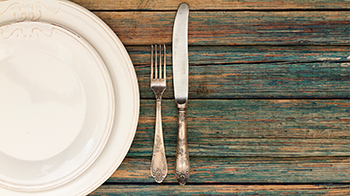More Health and Nutrition Bites
Related
Fool yourself with plate design
Researchers have been experimenting with the plates we eat from for a while. Back in 2006 I told you about a study in which nutrition experts where given two different sizes of bowls and spoons and were invited to serve themselves ice cream. Even though they probably should have known better, those with the larger bowls and spoons served themselves more ice cream and ate more than those with the smaller bowls and spoons.
Plating Matters
Back in 2011 I told you about a group of studies that compared different food presentations on how much people liked the food. One study compared "balanced" and "unbalanced" presentations, a second compared "neat" to "messy," and a third had the subjects just look at pictures of the food used in the two previous studies, without actually tasting the food. They found that more balanced, neater presentations of such simple meals as hummus and vegetables or chicken salad were perceived to taste better.
Small Plates? Just a Myth
Just last month I reported on a study that concluded that children will eat more when presented with a larger amount of food. Another study seemed to show that using a larger bowl (or plate, presumably) would result in serving and eating more than if a regular-sized bowl is used. These studies seem to shore up the widely-held belief that using smaller plates will help you eat less.
Health & Nutrition Bites
Get the latest health and diet news - along with what you can do about it - sent to your Inbox once a week. Get Dr. Gourmet's Health and Nutrition Bites sent to you via email. Sign up now!
Better research on the impact of smaller plates

It's passed into conventional wisdom: the idea that manipulating the plate you eat from can fool you into eating less. Some say that eating from a smaller plate will have that effect, but the quality of the research is questionable, with other studies showing plate size having no effect on how much people ate.
An international team of researchers conducted a feeding study (Int J Beh Nutr Phys Act 2019;16:75) at a feeding laboratory specifically designed for their research: a lounge with a dining table and chair, a sofa and bookshelves, and a television showing a nature program.
The 134 adult men and women were served a lunch, presented on a heated serving table in the room, consisting of either a vegetarian cheese and pasta bake or chicken korma curry. The participants were randomly given either a large or small plate and were instructed to serve themselves from the serving dish on the heated table and to consume as much or as little as they wished.
They were given 30 minutes to eat, during which they were filmed with hidden cameras. (The participants were told ahead of time that they would be filmed: the cameras were hidden to minimize self-consciousness on the part of the participants.)
Not only did the authors weigh the amount the participants served themselves, as well as the actual amount consumed, but they also took note of how many times they served themselves, how many minutes the participants spent eating, and how many bites they took (and thus the average size of each bite).
The two test plates were circular, white china plates with no decoration to distract the eye. The large plate was 29 centimeters across (about 11.4 inches), while the small plate was 23 centimeters across (about 9 inches).
After analyzing how much food was consumed, the authors found that "there was no clear evidence of a difference in calories consumed between the plate size groups." Further, the only other measure, from time spent eating to bite size, that was statistically significant between the two groups was how much food was left on the plate: those using the larger plate left about 1/3 ounce more on their plate, uneaten, than those with a smaller plate.
What this means for you
The authors note that using smaller plates is common advice, even from quite reputable sources (including myself). They say, "The current evidence is... insufficiently conclusive to either endorse or refute such advice." Which is not to say, they admit, that this can't be one of several methods, both proven and unproven, that people use to try to control their intake.
My advice? What's important here is not the size of the plate, but knowing what is an appropriate portion size. If using a smaller plate helps you feel more satisfied with a smaller portion size than you are used to, by all means, use it. Don't assume, however, that using a smaller plate will automatically mean you are eating less.
First posted: October 16, 2019
